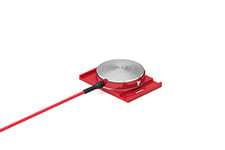What are Brake-by-wire systems?
Brake-by-wire (BbW) systems are an emerging technology that is currently used in Formula 1 race cars and certain luxury vehicles. The system, which is faster and more precise than traditional brakes, controls a car’s brakes electronically.
How do BbW systems work?
There is no physical mechanical link between the calipers and the brake pedal. Instead, the pedal functions as a simulator. When a driver steps on it, the force is measured by sensors that immediately communicate the braking information to the Brake Control Unit (BCU). The BCU processes this information and sends a command to electro-hydraulic actuators, which converts the command signal into caliper hydraulic pressure/clamping force, which in turn slows or stops the vehicle.
How are force sensors used in Brake-by-Wire design validation?
While BbW systems have yet to be successfully introduced in series production, they are expected to become mainstream in the near future. As car manufacturers are designing their own brake-by-wire systems they have to address issues of cost, reliability, and safety concerns. This makes rigorous durability and fatigue testing all the more crucial. FUTEK supports BbW system manufacturers by offering sensors that are optimized for the brake pedal and caliper testing. This application note illustrates how load cell and force sensors can be applied for design validation and calibration.
Automotive Industry Standards Compliance
ISO 7975: Passenger cars - Braking in a turn - Open-loop test method;
ISO 26262-1:2018 Road vehicles - Functional safety
SAE J2909: Light Vehicle Dry & Wet Stopping Distance Test Procedure (brake testing);
ECE R13H: Provisions for passenger cars braking;
How it Works
Brake pedals force: Brake by wire system validation is normally carried out during various stages of the manufacturing process. It starts in the initial development stage, followed by endurance, lab and track testing, and continues through the production process for added quality assurance.
Utilizing FUTEK's LAU220 Pedal Force Sensors (aka Brake Load Cell), automotive manufacturers are able to verify the safety and reliability of brake by wire system. Pedal Force Sensors are designed to measure load applied to the brake, accelerator, and clutch pedals during acceleration, deceleration, and transmission shift events.Brake caliper: In brake-by-wire systems, central controllers require accurate information about the clamping force between the brake pad and the disc as a function of pad displacement, which is usually denoted as the characteristic curve of the caliper. Due to aging, temperature, and other environmental variations, caliper characteristic curves vary with time. Therefore, caliper calibration is vital for high-performance braking action and vehicle safety. Plus, during design validation, engineers use force measurement system to validate and calibrate the brake by wire closed-loop systems. FUTEK's QLA307 Load Washer is low profile and can take massive loads, and is commonly used as caliper load cell for Brake Pad Testing.
Products in Use
LAU220 Pedal Force Sensor – Acceleration and brake pedals force testing;
QLA307 Low Profile Load Washer –Brake caliper testing.
Contact Us
Please Contact Us with questions.
What are Brake-by-wire systems?
Brake-by-wire (BbW) systems are an emerging technology that is currently used in Formula 1 race cars and certain luxury vehicles. The system, which is faster and more precise than traditional brakes, controls a car’s brakes electronically.
How do BbW systems work?
There is no physical mechanical link between the calipers and the brake pedal. Instead, the pedal functions as a simulator. When a driver steps on it, the force is measured by sensors that immediately communicate the braking information to the Brake Control Unit (BCU). The BCU processes this information and sends a command to electro-hydraulic actuators, which converts the command signal into caliper hydraulic pressure/clamping force, which in turn slows or stops the vehicle.
How are force sensors used in Brake-by-Wire design validation?
While BbW systems have yet to be successfully introduced in series production, they are expected to become mainstream in the near future. As car manufacturers are designing their own brake-by-wire systems they have to address issues of cost, reliability, and safety concerns. This makes rigorous durability and fatigue testing all the more crucial. FUTEK supports BbW system manufacturers by offering sensors that are optimized for the brake pedal and caliper testing. This application note illustrates how load cell and force sensors can be applied for design validation and calibration.
Automotive Industry Standards Compliance
ISO 7975: Passenger cars - Braking in a turn - Open-loop test method;
ISO 26262-1:2018 Road vehicles - Functional safety
SAE J2909: Light Vehicle Dry & Wet Stopping Distance Test Procedure (brake testing);
ECE R13H: Provisions for passenger cars braking;


